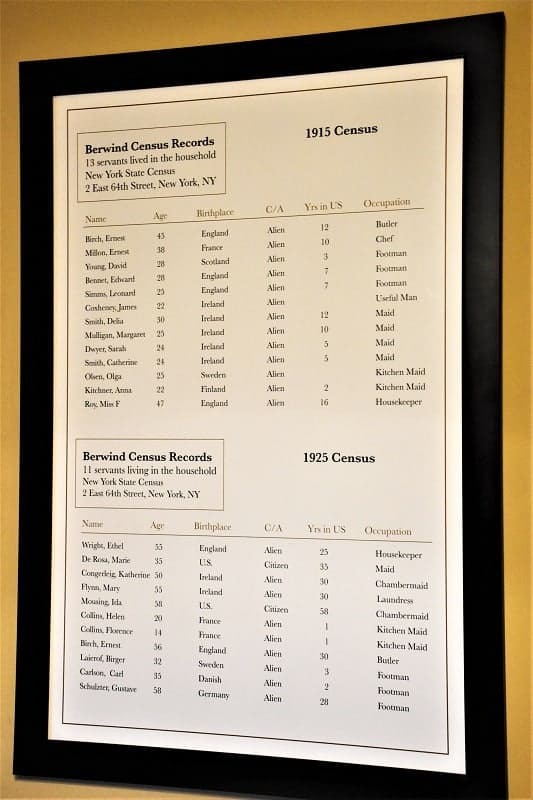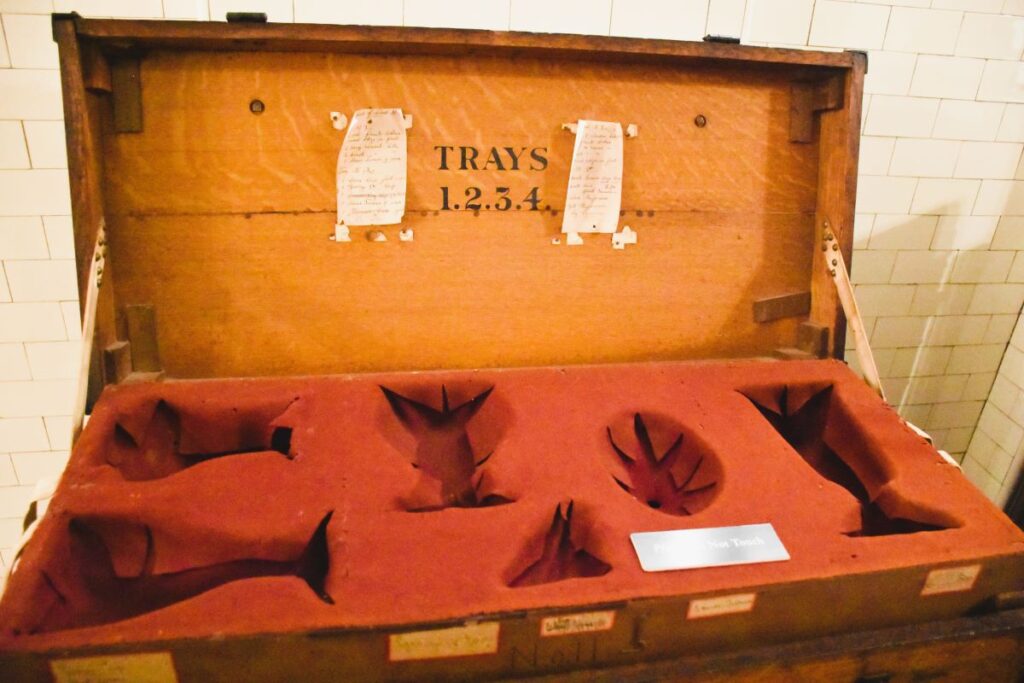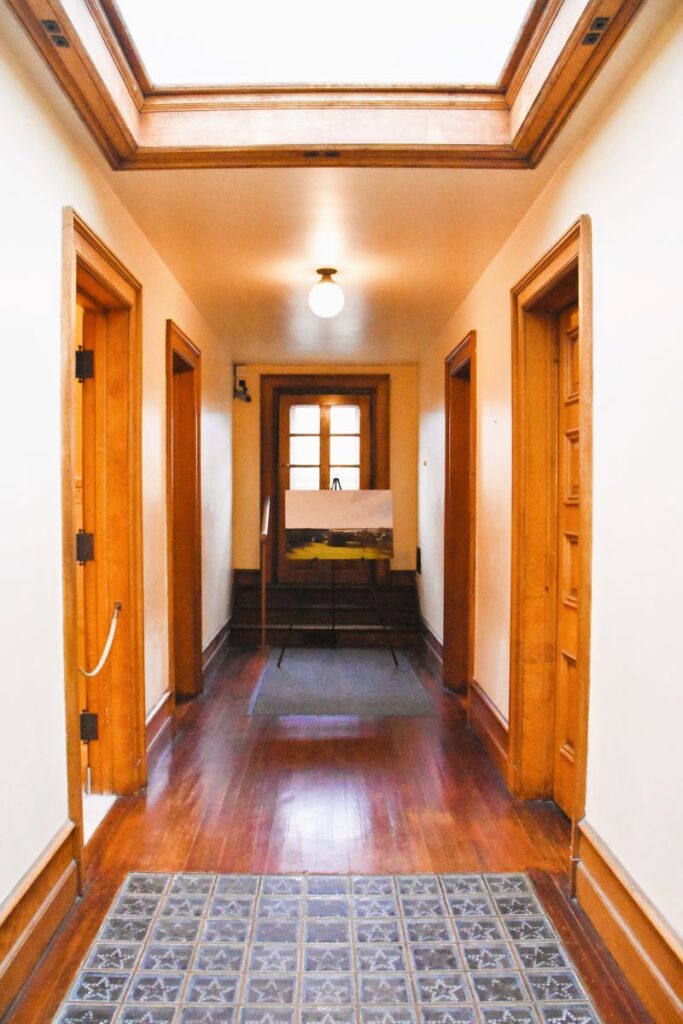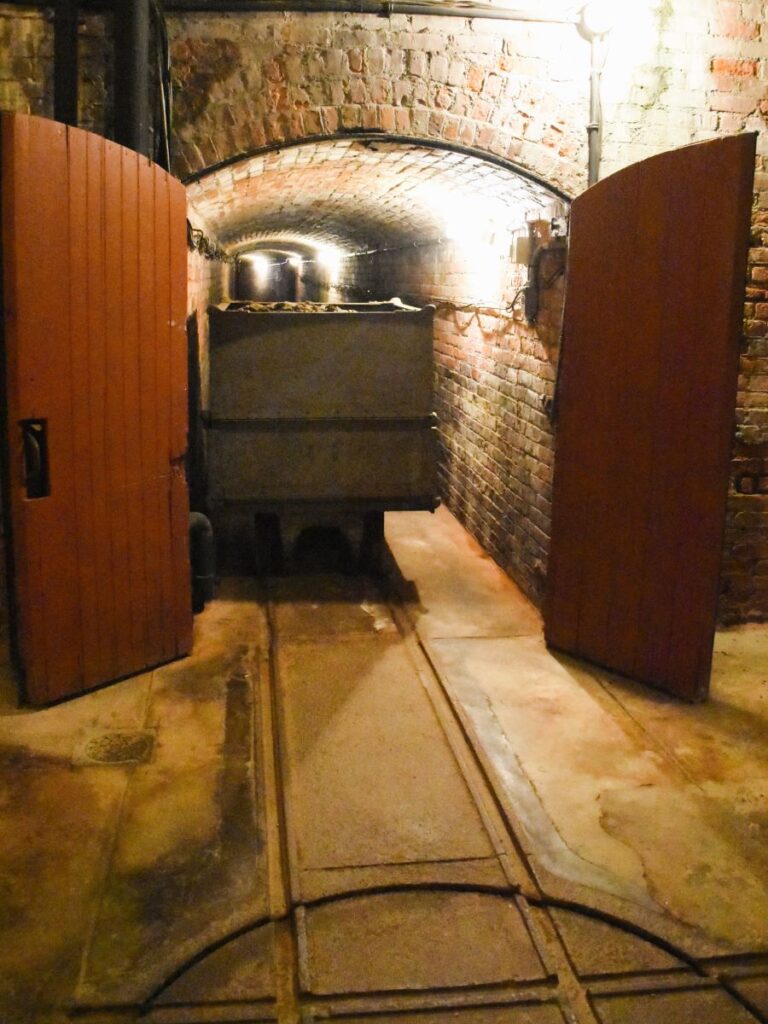Elms Mansion – Secrets of Gilded Age Servant Life
This site contains affiliate links to products or services that I recommend. Any purchases made through these links don’t add anything to your purchase price. It helps me keep the lights on and bring you quality travel tips. As an Amazon Associate, I earn from qualifying purchases. Thanks so much for your support!

Would you like to take a walk through The Elms Mansion servants’ spaces in Newport, Rhode Island? On the Servant Life tour you’ll go “downstairs” in the basement and up to the 3rd floor to learn the secrets of what servant life was like for those who worked for the wealthy in America during the over-the-top Gilded Age.
Did you see my first post about “The Elms Mansion – Perfect Tour for “The Gilded Age” TV Show Fans“? In that post, I shared a little about what life was like “upstairs’ for the wealthy families and their guests in Newport, Rhode Island during the Gilded Age and the connections with “The Gilded Age” TV show.

These upstairs-downstairs relationships remind me of what we saw in the British TV show, Downton Abbey and now we’re seeing it played out in the new Julian Fellowes TV series called “The Gilded Age”. The magnificent mansions in Newport, Rhode Island capture the affluence of the late 19th and early 20th centuries. A time that’s a little bit later than the Downton Abbey timeline in England. The wide gap between wealthy families and their working-class servants is much the same as at the Grantham era in England.
Were you a Downton Abbey TV show and movie fan? Did you know there’s a new American series about the Gilded Age, also written by Julian Fellowes? The HBO series explores similar upstairs-downstairs dynamics in America during the Gilded Age. It takes on issues of wealth and class in turn-of-the-century New York City. And where did the wealthy spend their summers? At their massive “cottages” in Newport, Rhode Island of course. You may already know that many of the TV show scenes have been filmed at the Newport Gilded Age mansions, like The Elms.
Servant Life in the Gilded Age
It was a rainy day when we took the tour of The Elms, so our route was a little different than normal. In most cases, the tour guide makes a point to walk visitors around to the side servants’ and delivery entrance (photo below) because servants never entered the house through the main entry door.
The servants, tradespeople, and deliveries all came in through a circular drive on the side of the house that led to the ground floor working area. The driveway is still covered and hidden with wisteria vines just as it was when the Berwind family lived there.

This helped in a few ways. First, the view of the servants and delivery wagons and trucks was blocked when guests looked out the windows from the main house. The thick leaves looked like a carpet of green from above. The vines also helped to muffle the sounds of the noisy trucks that made deliveries throughout the day. It would have been totally unacceptable for all that noise, commotion, and dirt to be brought in through the main entrance upstairs in this gorgeous Gilded Age mansion. Remember the back entrance at Downton Abbey? The same rules applied there. Servants and workers never came through the front door.
Servant Life Tour “Downstairs”
The Elms Gilded Age mansion opened in the summer of 1901. There were 27 outside staff people to care for the building and grounds, and 16 inside servants at that time. It seems like a high number considering the Berwinds didn’t have any children. Most of the servants came from England and Ireland where they likely received training before leaving their home country. The chef was from France, which isn’t a surprise considering the rich culinary history of that country. If you’d like to know more about French cuisine, take a look at my post about our visit to France and “The Four C’s of Normandy France Cuisine“.
There was a difference between American and European servants. Even though many servants were from Europe, they had more hope for a way out in America. Once they were here it was a stepping stone to bigger and better things outside of domestic service. There wasn’t the expectation or social restrictions that a servant would stay in service to a family for life, as it was in Europe.

The Berwind’s British Butler, Ernest Birch is one of the exceptions. He stayed with the family for several decades. You can see his name on the census in both 1915 and 1925. When Mr. Berwind died in 1936, he left $5000 to Mr. Birch. That’s equivalent to about $85,000 today. While I’m sure Mr. Birch sacrificed much for the Berwind family, it’s nice to know that there was extra appreciation shown for his commitment, because that certainly wasn’t expected.
In 1936 Edward Berwind left the Elms “Gilded Age” mansion in his will to his sister, Julia. She continued to summer there with a full staff until her death at the age of 96 in 1961. It’s rumored that when she didn’t have a 4th person for a game of cards she asked her butler to “stand in”. Out of respect for Ms. Berwind and the other guests, he played the game standing up. Can you imagine Mr. Carson, the butler at “Downton Abbey” sitting down with Lord Grantham for a friendly game? Of course not!
Moving the Household Each Season
Most of the servants and staff traveled on a similar schedule to the Berwind family. Every summer they moved from their home on 5th Avenue in New York City, NY to The Elms Mansion which they called their “cottage” in Newport, RI. The servants always went several days earlier to get the house opened up, cleaned, stocked, and ready for the family to arrive. I learned on the tour that even the family silverware and silver service traveled back and forth. It was stored in a massive walk-in safe, as big as a bank vault.

Long Hours and Lots of Stairs
The servants had to be available at a moment’s notice at all hours of the day and night to meet the needs of the families in these massive Gilded Age mansions. This contrasted with the families’ endless leisure activities and lounging between multiple changes of clothes. Servants generally had only one evening and one afternoon off each week, not necessarily on the same day
In an article about American Maids from the Readex Blog –
“The lady’s maid was expected to bring her mistress breakfast in bed, help her dress and undress (as many as five times a day), maintain and select her mistress’s wardrobe and jewelry, and style her hair. A skilled lady’s maid was much valued. Such a woman often served as a beautician and stylist.“
Before telephones or electric intercoms, the annunciator box below is used to communicate with the staff. The Berwinds had the capability of speaking to the servants over the “phones” from nearly every room to explain what they wanted before the servants set out. This saved time and steps for the servants.

Servants’ Spaces Like The Gilded Age
Just as in the Gilded Age TV show, the back stairs are where the magic happened. Servants climbed up and down countless times from the basement kitchen, laundry, and storage areas to the main and 2nd floors where the family lived. Then climbed the stairs once more at the end of their long day to get to the 3rd-floor servants’ quarters.

The servants’ floor at The Elms has 16 good-sized bedrooms and 3 large shared bathrooms. It was a co-ed space where only single servants lived. Married couples either lived off-site or in cottages on the grounds, similar to the British “Downton Abbey” estate. The servants were given reasonably sized bedrooms for the time, but they were actually quite small and plain compared to the lavish family bedrooms that we saw in the family bedrooms in the “Upstairs” tour.

In the photo below you can see the skylight (that I talked about in my previous post). The sunlight streams through the roof of the servants’ quarters, then down through the glass block on the floor. This lights up the hallway in the 2nd-floor family area. Electricity was a new invention and bulbs still weren’t very bright, so the extra sunlight and passive lighting was a welcome addition and energy saver.

Notice the painting of a landscape at the end of the hall [see close-up below]? That’s the view from the roof just outside the servants’ quarters. The tour group usually has a chance to step outside onto the roof terrace to enjoy the view, just as the servants did. Unfortunately, our rainy day tour made that a little too risky.

Why is There a Rail Line in the Cellar?
One luxury that the Berwind family had that was probably not available in other homes, was a private coal delivery system. Mr. Berwind’s “new money” wealth came from the coal industry. That made it important for him to have access to every comfort that coal power could provide. When he built the Elms he also built an underground tunnel from the street to the lowest level of the basement. This way coal could be brought directly to the furnaces without disrupting other areas of the estate.

Learn about Life Upstairs for the Family
If you haven’t already, be sure to read my post about how the other side of the household lives “upstairs”. “The Elms Mansion – Perfect Tour for “The Gilded Age” TV Show Fans”
The Elms – Servant Life Tour Info
I hope this gives you a taste of just some of the things you’ll learn about servant life in the Gilded Age of America. If you’re planning to visit Newport, Rhode Island, the Elms Mansion guided Servant Life Tour tickets can be purchased in advance online here. Please note that the Servant Life Tour is a separate ticket from the main self-guided Elms Mansion tour. Be sure to get both if you want to see the contrasts between upstairs and downstairs life.
You can find out all about the operating schedule and ticket info for all 11 mansions at the Gilded Age Newport Mansions site here. Hours, tours, and home availability change seasonally, so be sure to check before you go. Some tours are guided by volunteer docents, while others are self-guided. The self-guided tours offer free headsets and easy-to-use devices that are packed with information and stories about the homes and the people who lived in them.
More Fun Around Newport, RI
Booking your trip? Here are some of the resources I use myself:
-Book great deals on flights with Cheap-o-Air
-Discover cool lodging with Booking.com
-Find the best prices and perks for cruises at CruiseDirect.com
-Reserve your vacation home rental with VRBO
-Book your car rental with RentalCars.com
-Buy your travel insurance with InsureMyTrip
-Book unique travel tours with Get Your Guide and Viator
-Find delicious culinary experiences with EatWith
-Find even more of my favorite travel resources here.
When you use these links I earn a small commission, at no extra cost to you. This helps me pay the bills and allows me to continue to create and share free tips and advice to help you travel better. As an Amazon Associate I earn from qualifying purchases.
What Would You Do in the Gilded Age?
Have you ever been to the Newport Mansions? What do you think about those class differences? Would you have been willing to be a servant in a strange country to get a fresh start and have access to those gorgeous homes of the rich and famous? It’s interesting to think about what life might have been like and what choices you would have made in the Gilded Age in America.







